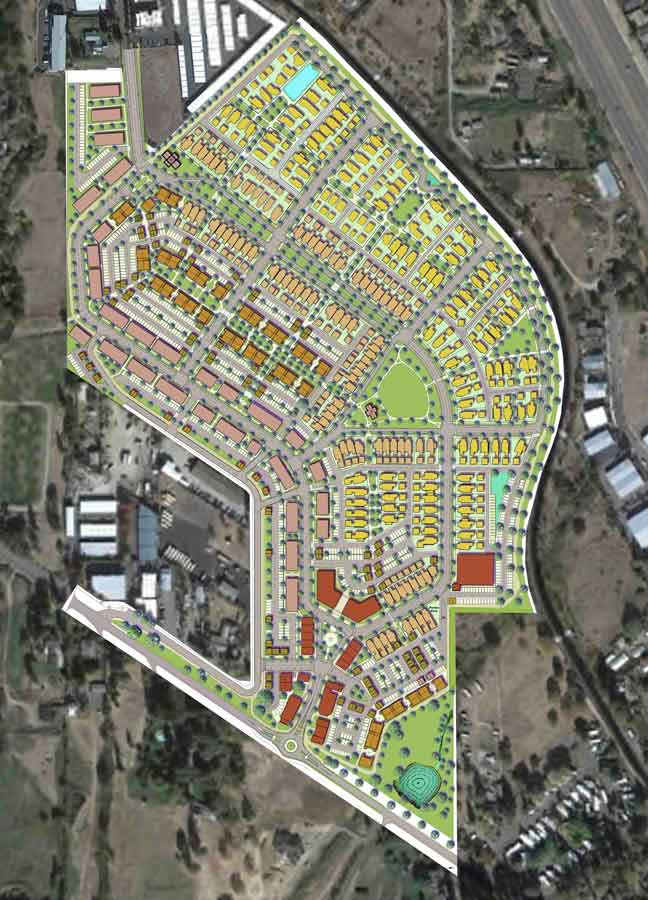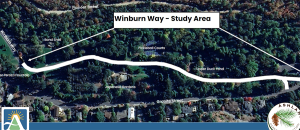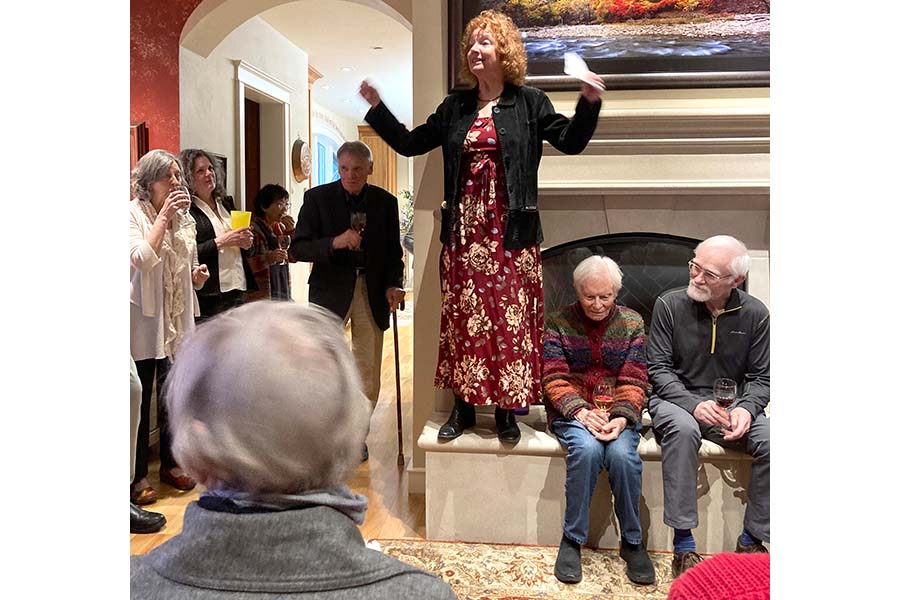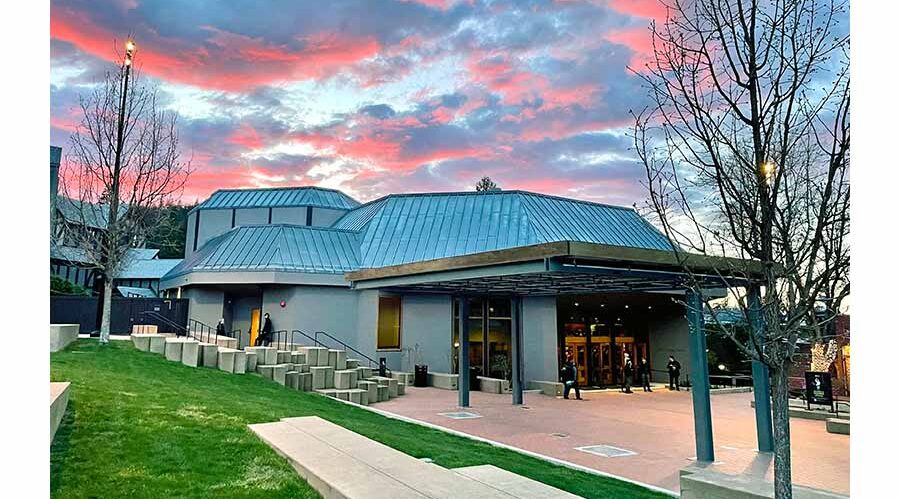What’s now called the Ashland Mill project is the largest development proposal in Ashland history
By Craig Breon for Ashland.news
Plans for Ashland Mill — the largest development proposal in Ashland’s history — are now in the hands of the city.
In early October, Townmakers LLC filed a formal application to build what the developers call a “complete community” on 61 acres of Ashland’s southeast side. Housing, commercial areas for restaurants and shops, small business workspaces, and public amenities such as trails and small parks will, according to Townmakers, create a “place to connect” for both the immediate area’s residents and for Ashlanders as a whole.
The product of a three-and-a-half-year planning effort to date, Ashland Mill — formerly known as the Croman Mill site and still part of Ashland’s Croman Mill district — should move to Planning Commission and City Council hearings within 60 to 120 days. Both the commission and council have previously convened study sessions on the proposal as it formed, with largely enthusiastic feedback.
Townmakers LLC specializes in planning mixed-use development. In a recent interview, lead planner Michael Mehaffy pointed to his past work on the Orenco Station project in Hillsboro, Oregon, as an example of a successful, somewhat larger scale, mixed-use project.

There are locals, however, with strong concerns about so large an effort and its impact on Ashland now and into the future. Some downtown businesses have expressed unease in placing a potentially competitive commercial district on the other end of town, though the size of the commercial area at Ashland Mill would be considerably smaller than the downtown and would not contain a major draw such as the Oregon Shakespeare Festival or Lithia Park.
Townmakers’ lead planner, Michael Mehaffy, claims Ashland Mill provides, “a different kind of offering from the downtown.”
In addition, a number of Ashland residents, and a couple council members, have in the past raised doubts as to whether the housing component of the project would serve the needs of existing Ashland residents and local workers as compared to continuing the trend of attracting workers and retirees from outside the region. This could depend on the ratio of single-family homes or townhouses to multi-family apartments, and overall affordability. Townmakers representatives acknowledge these criticisms and assert that they have addressed them with the project’s diversity of housing.
As proposed, Ashland Mill’s site plan includes a varied housing stock: 116 detached single-family units, 90 single-family attached, 73 carriage houses (aka accessory dwelling units or granny units), and 259 multi-family units.

Beyond housing, Ashland Mill would include 35,000 square feet of retail space, a hotel, a wellness center, and nearly 100,000 square feet of light industrial buildings, designed to accommodate small employers, with potential for live/work units.
Croman Mill was a working timber mill until 1996. Ashland was founded largely as a timber mill town, with a half-dozen mills at their peak. The city’s original name was Ashland Mills.
One legacy of that timber history is soil contaminated by toxic chemicals, substances used by the mills or byproducts of the milling process, prior to more strict standards for storage and disposal of potentially harmful chemicals. The Croman Mill site is currently undergoing a clean-up process, led by current landowners Dwain & Bud LLC, under the guidance of the Oregon Department of Environmental Quality. The majority of the clean-up is underway, but Townmakers expects to have smaller clean-up requirements to address upon commencement of grading and other construction activities.
Partially due to the known toxic contamination of the site, Croman Mill was long planned for more industrial uses. Clean-up standards are lower for industrial development than for residential uses.
Additionally, previous Ashland planning envisioned the need for more job-producing sites. Over time, the city’s focus has shifted to a now-paramount need for housing, especially affordable housing. Ashland Mill will be required to provide some dedicated affordable housing, and Townmakers believes the apartments and carriage units will provide more affordable price points, even at market rates.
As recently as a year ago, the Croman Mill site was seen as the linchpin in Ashland’s efforts to comply with an Oregon program called Climate Friendly and Equitable Communities (CFEC). To address climate change, CFEC requires larger communities throughout the state to plan for 30% of their housing to be located in areas deemed Climate Friendly Communities (CFCs), walkable areas designed to reduce carbon emissions by making it easy for people to live, work and meet their daily needs without driving. The CFC standards virtually dictate more dense, mixed-use areas, as Ashland Mill aspires to.
The Croman Mill site was left off the final plan for Ashland’s CFCs due to questions of timing and whether the density of the development would reach the required CFEC standard of at least 15 residential units to the acre. This residential density, along with significant employment density, is sometimes used as a guideline for when a development area is dense enough to support a bus line with frequent stops.
Ashland Mill is in negotiations with Rogue Valley Transportation District (RVTD) regarding a bus line.
According to Townmakers, their residential zone will be at 18 units to the acre. Michael Weinstock, who heads Townmakers, claims, “What we’re proposing is in line with state climate goals.”
Perhaps more than density and mixed use, Townmakers emphasizes the “connectivity” proposed for Ashland Mill. Asked to explain, Mehaffy emphasized, “generous sidewalks and pathways,” a greenway faced with homes fronted by porches, and a “human scale.”
Highlights include the extension of the city’s Central Bike Path, which runs generally along railroad tracks across Ashland from Railroad Park on the north to Tolman Creek Road at Mistletoe Road on the south, not far from the Shop’n Kart/Bi-Mart shopping plaza.
Walking from virtually any place within Ashland Mill to the central retail area should take five minutes or less.
To reduce car dependency further, Townmakers plans for innovative pricing for some parking spaces (known as “unbundled parking”), where a given carriage house resident, for example, could opt to pay more for a dedicated parking space or forego that and rely on walking, biking, and other transport options.
In conformance with state law, Ashland cannot now impose minimum parking requirements on most developments, so reliance on alternatives such as projected significant growth in use of electric bicycles will be crucial to making feasible projects such as Ashland Mill or the Grand Terrace apartments proposed for the northwest end of the city.
Townmakers is also considering a carshare program.
To further address climate change and reduce indoor air pollutants, Ashland Mill will not offer natural gas in residential units. Commercial and industrial areas will allow natural gas, as certain businesses, such as a pottery manufacturer, cannot generally use all-electric power.
Townmakers is also looking at solar power and groundsource heat pumps, but has not committed to such items. Weinstock notes, “We want to under-promise and over-deliver,”
Email Ashland resident, consultant and former environmental law instructor Craig Breon at [email protected].
Related stories:
Study could serve as a guide for future Ashland business development (April 24, 2025)
Ashland’s Climate Friendly Area discussion focuses on Railroad Property and Transit Triangle (Oct. 29, 2024)
Public open house Tuesday focuses on Climate Friendly Areas (Sept. 15, 2024)
Council agrees: A denser Ashland would make more city more ‘liveable’ (July 18, 2024)
Council Corner: We need to develop the city’s Southside (March 15, 2024)
Croman Mill development moving briskly forward (Feb. 10, 2024)
Council looks at progress on key Croman Mill site (Nov. 8, 2023)
Ashland close to designating Climate Friendly Areas for development (Sept. 15, 2023)
Croman Mill site needs cleanup, but figures to be major new Ashland neighborhood — eventually (Aug. 7, 2023)
Ashland’s ‘Climate Friendly Neighborhood’ focus falls on Croman Mill, railroad properties (April 15, 2023)
Ashland Past Times: A town of many mills (May 23, 2022)





















